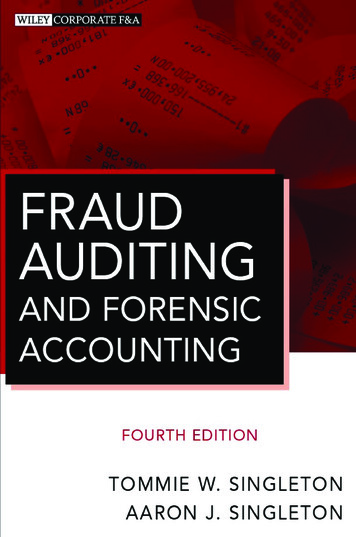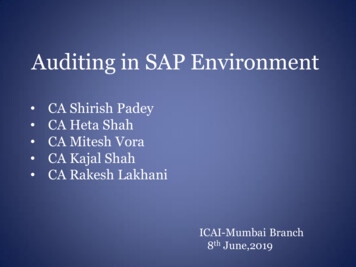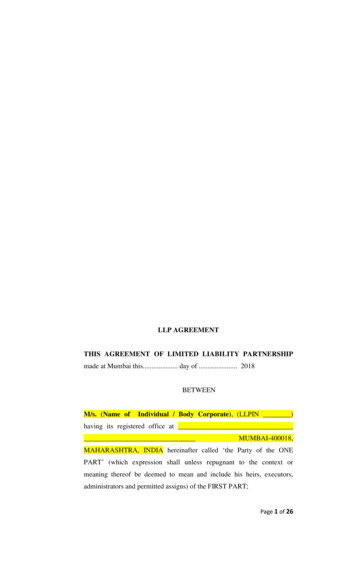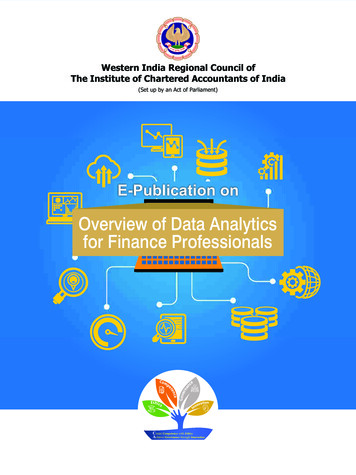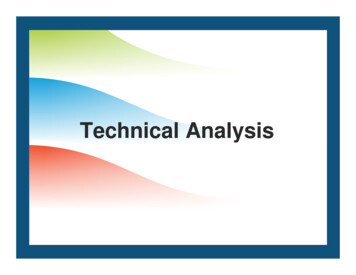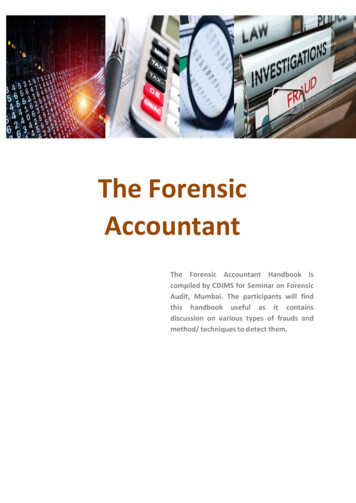
Transcription
The ForensicAccountantThe Forensic Accountant Handbook iscompiled by CDIMS for Seminar on ForensicAudit, Mumbai. The participants will findthis handbook useful as it containsdiscussion on various types of frauds andmethod/ techniques to detect them.
The forensic accountant handbook- by Chetan Dalal and Mahesh BhatkiThe For e nsic Acc ountant ’s Hand BookCompiled by Chetan Dalal, Mahesh Bhatki,Jatin Jhaveri, Rajan Gupte and Govindsingh PurohitContents1. Early Warning Bells, red flags and common fraud scenarios2. Case Studies on business fraud- ‘distrust the obvious’ the green flag syndrome3. Introduction to mathematical and quantitative techniques for investigation4. Elements of Interviewing5. Field investigations and use of tools and electronic devices within legal rights6. Computer Aided Audit Techniques and Tools (CAATTs)Notice and DisclaimerWithout the prior consent of the author, no part of this compilation may be copied, reproduced, stored or transmitted in any form or by a nymeans including without limitation by means of electronic, mechanical, photocopying, recording or otherwise. The opinions and viewsexpressed in this compilation are without prejudice and are based on experience of the authors, research or based on empirica l studies.The material is purely for academic educational purposes and should not be construed as professional advice. The author does not warrantthat the views stated shall be effective in each and every case or may give predictable consequences. The author shall not be responsiblefor the result of any action taken on the basis of this work whether directly or indirectly and for any errors or omissions in the work. Theauthors expressly disclaim all and any liability and responsibility to any reader of whatsoever in nature. References to names in this handbookare merely fictional / imaginary and their resemblance to any living or non-living things, people or organizations are purely coincidental.Page 2
The forensic accountant handbook- by Chetan Dalal and Mahesh BhatkiChapter 1. Early Warning Bells, red flags and common fraud scenariosIn modern times fraud is not only rampant but also exponentially large in magnitude.This is because perpetrators of fraud are an intellectual lot and have the ability tocamouflage their wrongdoings. Consequently, whenever any important decision is tobe taken, be it budgeting, financial cash flows or even high-level corporate decisionssuch as takeover or mergers, project appraisals or any financial major commitment,the specter of fraud, deception and overall risk looms high. The key issue is thereforeto have some system of discerning early warning bells or to apply methods to spot redflags of potential risk, before taking any major step forward. No doubt, lot of effort indue diligence exercises is being put in, but more often than not, there are glaringomissions which are very clear only when disaster eventually strikes and it is too late.Is there a way to minimize such risk and to enhance the probability of nipping fraud inits initial stages?Funnily enough there is no great rocket technology involved. Generally speaking, it ismore or common sense, logic and a whole lot of patience in absorbing an d digestinginformation available. The central thrust is to detect anomalies and inconsistencies.However, to be a little more specific, there are some simple commonplace red flagswhich most fraud investigators look for in scenarios of financial evaluations and someof them are explained below. If these red flags are hunted or searched for in financialreviews, even in audits, the probability of fraud being detected in early stages wouldbe significantly greater.1. Hunting for secret reserves. There could be situations where funds are maskedor hidden. This could be done for any reason such as concealing the correctfund position, or for keeping funds aside for future misuse or embezzlement.Such practices can also be applied to give an incorrect position duringtakeovers, mergers or other instances of recovery of defaulting borrowers.Perpetrators of fraud use infinite number of ways to hide such funds. The mostcommon way is to make illusionary payments or payments to fictitious parties.The effect of such payments is to reduce the bank balance in the financialaccounts, but in reality, since there is no payee there is no one to present thecheques. Consequently, the funds are very much there, which can beembezzled at a later date when the opportunity arises. What are the red flagswhich can be hunted for to reveal secret reserves? There are several. The firstand the most revealing method is to determine whether there are stale chequesin the system. Stale cheques are cheques issued to payees who have notPage 3
The forensic accountant handbook- by Chetan Dalal and Mahesh Bhatkipresented the cheques for payment for over six months. As we all know acheque become invalid six months after the date of its issue. Such stale chequesare secret reserves if they appear in the bank reconciliation statement (BRS).BRS is a simple comparison and reconciliation statement between the balanceas shown in the bank statement ( bank passbook) and the cash book maintainedby the entity. All cheques issued by the entity but not presented by the payeeswill appear as unreconciled entries in the bank reconciliation statement. Stalecheques remain unquestionably secret reserves as long as they appear in thebank reconciliation statement. They cease to be secret reserves only after theyare removed from the BRS by an appropriate accounting done in the books ofaccount, which is seldom done. This secret reserve concept can be furtherextended even to such unpresented cheques more than one month old,because there is a 90 % chance that these payees are non-existent or that theyhave not been handed over these cheques for ulterior motives. Therefore everydue diligence exercise would do well to ask for a complete list of bank accountsin use and bank statements for each of these must be examined along with theBRS for secret reserves as explained above. Another method of hunting forsecret reserves is a study of the liabilities to third parties. Very oftenperpetrators create liabilities in books without any sound basis. The intentioncould be to show a lesser profit, or to create an incorrect liability for futureencashment through accomplices at an opportune time. Red flags can bespotted by studying accounting behavior of creditors and third parties. Imagineif vendors, suppliers or creditors do not ask for payment of large amounts dueto them as per the books of account, for months together- is this possible inrecessionary conditions? Unlikely. Such dormant or well behaved creditors areillusionary. A simple scrutiny of third party payables will clearly show those whoare reluctant to ask for payments. More often than not these are not reallypayable.2. Distinguishing exaggerated expenses or business losses from underlyingtechniques of siphoning out of fundsThere are also ways and means adopted by perpetrators of fraud for dupinginvestors and equity partners or potential acquirers of business. Exaggeratedincomes, sales, receipts and/or deflated expenses are very possible. This isdone with a view to improve the share prices at the time of the takeover. Thereare ingenious ways of doing this. In one unique case, where the takeover of abusiness was to be spread over three years, the previous management was toldPage 4
The forensic accountant handbook- by Chetan Dalal and Mahesh Bhatkithat company taking over had a norm of permitting a maximum of 3 % loss onaccount of rejections or wastage. However little did that company realize thatit gave away an important piece of information- that it tolerated 3 % rejectionwhich was much higher than that of the previous management whose companywas being acquired was much lower at about 0.25% because of a slightly betterkind of machine. Needless to state the previous management exploited thesituation fully and during the phase wise takeover period in 3 years duringwhich they had the operating authority, they smoothly and covertly creamedoff the difference of 2.75 % rejection which in absolute terms ran in to severalcrores of rupees. Such malpractices can happen in myriad number of ways.How can one really spot these manipulations? Admittedly it is very difficult.However, these need lucid thinking and a multi-pronged approach. Apart fromfinancial and legal due diligence, there need to be certain important key factorsto be probed into for each industry- gross margin, wastage, yield and inventoryratios etc. More importantly the due diligence must continue even during thetakeover process (using intelligence agencies), and for some time after thetakeover till such time that the new management completely takes over. This isto protect and inform the new management of business diversion,opportunities lost or transferred to other entities, and other abuses which takeplace in a big way even through old loyal employees. Use of ‘moles’ asemployees, suppliers or third parties can also be useful .3. Spotting illusionary revenues and profits.This is perhaps the most difficult. This can be done in two broad ways: inflationof income or deflation of expense. In many cases the expenses cannot bedeflated but they can be postponed till a later date or the happening of an eventwherein they could be explained away without inviting penal action. Forexample in an investment and financial trading company an amount of Rs 1.8million was given to a broking house for speculation and investment by a juniorfund manager. Somehow the decisions of the junior fund manager wenthaywire and Rs 1.8 million was lost in speculation and there was nothing leftrecoverable from the broking house. The fund manager who was responsiblefor this fund, manipulated and did not record the trades for some months. Hewas getting desperate, but his patience paid off and luck was on his side. Hisboss who was the main fund manager was caught in another major scam andthat manager absconded. The junior fund manager took his place. The entireRs. 1.8 million loss was attributed and palmed off to decisions taken by thePage 5
The forensic accountant handbook- by Chetan Dalal and Mahesh Bhatkiabsconding fund manager and the junior fund manager escaped the wrath ofthe management for his own misdeeds. Fraudsters are always on the lookoutfor such opportunities as the sudden departure, death, or other cloakingdevices for their own sins. There are two ways to tackle this. One, there has tobe an evaluation of accounting discipline; arrears of accounting, updates,reconciliations are clear red flags as also thriving grounds for fraudsters. In fact,all such situations of chaos, disaster (e.g. computer breakdowns, fire, etc.),arrears of accounts, missing records, and sloppy accounting are the hallmarksof an intelligent mastermind of a group of fraudsters, and the most lethal. Theseare all used to bolster illusionary profits or suppress disaster situations.Secondly any situation of profits not matching reality must be taken with apinch of salt. For example, huge balances of cash and bank accounts or fixeddeposits as against huge over draft balances indicate that in reality thecompany may not have that much cash. Similarly, huge unexecuted orders forstocks cannot exist logically with huge stocks over re-order levels without anyjustification of huge pending orders. Another case was in a situation of war,where a hotel was situated close to the enemy territory, there was a suddenincrease in profits because of an upsurge in tourism and increase in hoteloccupancy just before it was lost by fire for which an insurance claim wasreceived for loss of profits. Such anomalies can be spotted only when the entirebusiness is viewed both on a micro as well as macro basis within theenvironment. It is not easy, but can be done with a little patience and someresearch and some clear logical thinking.As mentioned before, the methods employed by perpetrators of fraud aremany and ingenious. However they thrive because of predictable, mundaneand standardized methods of review, due diligence and inquiry. Innovative,imaginative and common sense methods can help substantially more inferreting out such fraud or at least in spotting red flags early.4. Spotting frauds at a micro level during investigations, audits and riskmanagement exercises.In order to find frauds at a macro level the forensic accountant looks at fraud risksituations with a bird’s eye view as compared to an ant’s view. A forensicaccountant does not look at individual controls for assessing the vulnerabilities butPage 6
The forensic accountant handbook- by Chetan Dalal and Mahesh Bhatkion environmental influences, organization culture, management vision, industrynorms and practices and broad policies and guidelines. There can be situations ata macro level, which are conducive for fraudsters. It is possible that such situationscan motivate and actually create fraudsters. Conversely, fraudsters can also createsuch situations. In either case, forensic accountants much view these situations as‘red flags’ and appropriate modify or extend his audit procedures. The followingare some typical fraud prone situations.5. Situation of disorderlinessChaos situation, filing indiscipline, arrears in book keeping are usually situationswhere a perpetrator’s actions are not easily traceable. The advantage that aperpetrator has, in such situations, is that he can lead an forensic accountant offtrack quite easily. Even if a record or document is available in his drawer, it becomesfairly simple for him to palm it off as untraceable. In most situations, arrears inaccounts are a result of fraud rather than non-availability of resources. It may beworthwhile for the forensic accountant to ascertain the responsibility andownership of the records, the persons who authorized or who have been authorizedin the past to have access to these records. It is quite likely that a potential fraudstercould be one of these. This red flag when viewed with the other behavioral red flagswould give the forensic accountant a better insight into the situation and enable himto identify red flags and eventually detect fraud, if any, existent.6. Disaster situationsThe best camouflage is available to a perpetrator of fraud where some disasterhas taken place. For example, where a fire has occurred and its assets andrecords have been destroyed, it is very simple for an auditee to inflate theinventory of items lost by fire to include fictitious items, items stolen/pilferedin the insurance claim. The convenience of disclosing or not disclosing anavailable record to the surveyors and investigators is usually exploited by mostclaimants. Most insurance claims for stocks lost by fire are therefore potentialhigh fraud prone situations. Therefore in large value claims many insurancecompanies seek help of specialist investigators or accountants to correctlyassess the claim.Page 7
The forensic accountant handbook- by Chetan Dalal and Mahesh BhatkiExampleAn interesting case of such a disaster claim happened in a supermarketwhich was ravaged by vandals during riots. There was a curfew in the city fortwo days after the riots during which the supermarket remained sealed bythe police and un-accessible. On the third day the supermarket presented asituation of complete disaster with stocks strewn all over having been lootedby the vandals. Each department manager was sent to his/her departmentto assess the damage and on the basis of consolidation of all suchdepartmental losses, a huge insurance claim was lodged for loss of stocksand cash. The surveyors got a forensic accountant along with them to takestock of the situation.To cut a long story short, the forensic accountant found that the cashier hadtaken advantage of the completely strewn and chaotic condition in thesupermarket. The cashier’s cabin was in the back office, which actually had notbeen affected by the riots. But taking advantage of the overall chaos he hadvandalized the back office himself. When he entered the cash cubicle he thoughtthat he could conveniently tear and break a few things around to make it appearthat the rioters had actually vandalized and stolen cash also. However, he wasgiven away by a simple mistake; he tore some faxes lying on the fax machine,which had been received in the back office after the riots took place i.e. duringthe period when the supermarket had been sealed by the police during thecurfew. Therefore since the cashier was the first person entering the cash cubicleafter the supermarket was reopened, it was logical that only he could have tornthose faxes and on interrogation he confessed. The point worth noting here isthat a disaster makes it so simple for any person to commit a wrongdoing that itvirtually offers an invitation. Another typical case is a bank robbery. Themanager’s own embezzlement could be neatly palmed off along with the moneystolen by the robbers. Earthquakes, fires, floods or any calamities are situations,where it is possible that a perpetrator could take advantage of palming off pastsins or yielding to temptations for new wrongdoings.Page 8
The forensic accountant handbook- by Chetan Dalal and Mahesh Bhatki7. Organizations left in the ‘Autopilot’ modeThere is a temple in South India which has a miraculous effect on visitors. The‘prasad’ or the divine food offering given to the visitors, tastes delicious only ifit is eaten within the precincts of the temple. If the prasad is eaten outside thetemple premises, it would taste bland. The symbolic interpretation is that theprasad will retain its divine qualities and taste good only if it is eaten in thepresence of the lord. Certain systems and internal controls are like this ‘prasad’.They will work well only in the presence of the stake holders or seniormanagement, however robust and well-designed they may otherwise be, andwhatever be the strength of built-in internal controls. In other words, whensuch systems are left on the ‘autopilot’ mode, they may fail to withstand attacksand contingencies from the external environment. What is this concept of‘autopilot’? Autopilot is a term used to refer to automatic operation of anairplane or a ship without requiring the presence or direct supervision from thepilot or the captain. It is a navigational device that automatically keeps ships,planes or spacecraft on a steady course. While having this autopilot feature hasconvenience, it can also be devastating if a regular check and supervision islacking.ExampleThis is exactly what happened even when a well-tested, robustcomputerized application for sales and cash collections accounting wasimplemented in a bakery, which was left to operate left on the ‘autopilot’mode. This bakery had been bought by a company ABCD a few years ago fromone of its partners DBP, when he had joined ABCD as a partner in the business.Till it was owned by DBP, it was personally run and supervised by DBP himself.After ABCD had taken over the bakery from DBP the bakery had been left torun under the local manager because there were good time tested systemsbuilt in to ensure that it operated satisfactorily. However, the bakerysubsequently started making cash losses. These losses of the bakery wereattributed to ‘drop in sales’ due to stiff competition from foreign brands, whoeven provided free home delivery, and wastage losses resulting in high inhouse costs of making breads and pastries. This had resulted in lesser footfallsin the bakery and consequently, lesser sales. The bakery had now come closeto going below the break-even point and the management was seriouslyconsidering closing the bakery business.Page 9
The forensic accountant handbook- by Chetan Dalal and Mahesh BhatkiThe forensic accountant visited the bakery which was at a far off location. Thoughthe application security and the physical security were indeed good, he realizedthat they had worked well only as long as they were implemented in the presenceof the DBP. His continued physical absence emboldened the local staff to find outingenious methods of beating the existing level of security. In this case theyexcused of power outages and the consequent computer-shut downs for resortingto issue of manual cash receipts. The management was told about this in a passingreference and it was led to believe that these were rare occurrences which did notwarrant a formal system and such manual receipts were issued only to maintainsales continuity during power breakdowns. On materiality grounds, themanagement did not think much of these receipts, but ground realities weredifferent. The power outages had become a daily two hour affair which themanagement did not know, and manual receipts accounted for about 15 % of dailycollections which were suppressed and since they were outside the sales system,they were easily embezzled. To justify the drop in sales, the management was ledto believe that the sales were falling because of competition and wastage lossesFor all its convenience, ‘autopilot’ mode is good for a short duration only andcan never be a permanent solution. Permanent autopilot mode can onlyencourage indifference and fraud on account of perceived safety.8. Sudden profits in an otherwise loss making business not supported by anyreasonable change in environmentIt is difficult to believe this, but it may be true that such profits could be illusionary.In fact even if the profits are translated into actual cash receipts they could bemisleading. In one such situation the directors argued with the forensic accountantthat since the sales proceeds were being regularly received in the banks, how couldthere be a fraud? The forensic accountant explained that the company’s owncapital was being watered. The fraud occurred in a five star hotel on a hill stationfar away from the nearest city. The hotel had been making continuous losses foryears together and the management had decided to close down the hotel and atemporary manager was locally appointed to carry on till the closing formalitieswere completed. Almost immediately thereafter, amazingly the hotel startedmaking sudden profits, and as the directors argued, the money was beingPage 10
The forensic accountant handbook- by Chetan Dalal and Mahesh Bhatkideposited in the bank. However after a detailed investigation it was found that themanager was deceiving the management by clandestinely selling the hotel’s ownvaluable teakwood furniture, expensive glassware and cutlery, paintings,chandeliers and other valuables and depositing a part of the collections in the bankostensibly as sales, and pocketing the balance himself. What was deposited in thebank as sales thrilled the directors because they really were disillusioned and feltthat the new manager had been able to make the hotel turn the corner. To keephis own fraud from being noticed, he would replace expensive valuables liketeakwood furniture, cutlery, etc. with ordinary commercial cheap replicas.9. Consistent losses in an otherwise thriving industryThis needs no explanation and it would be pretty evident to the forensicaccountant that losses are not justified. All that the forensic accountant needsto do is to ascertain whether the loss was on account of poor management orintentional mismanagement. This will depend upon exercise of judgment onpart of the forensic accountant based on his skills and experience. A fundmanager in a derivate trade market which was booming made a huge loss inthat period. It was difficult to believe that in such a market a huge loss could bemade. It was found that loss was made by entering into large value mindlesstrades which yielded losses. In reality the purchase and sale of the scrips weredeliberately done through two different brokers (which was unnecessary), sothat profits equivalent to the losses in the fund manager’s company weresiphoned out through an intermittent personal broker of the fund manager.10. Situation of incomplete information: Missing records, seizure of records byauthorities, etc.This is perhaps the strongest red flag of all. An occasional missing documentmay not be serious but a file or plenty of records missing are certain indicatorsof fraud in most cases. The missing records usually are so missing with theblessings of superior officers and managers of the organization and wouldgenerally indicate a more serious fraud with high level collusion. Similarly in thedays of paper records; corrections, white ink changes and alterations wereserious issues which would make an forensic accountant prick up his ears.Page 11
The forensic accountant handbook- by Chetan Dalal and Mahesh BhatkiHowever, in the paperless environment the focus shifts on user logs anddata/program changes. Frequent changes could be symptomatic of foul play.In a case of an internal audit of vendor empanelment and selection, an forensicaccountant observed that the addresses of several vendors were changed andre-changed back to the earlier addresses as per change logs available in thesystem. These had been done during the floating of the inquiries for certainvendors, to ensure that they did not receive the company’s purchase inquiriesand therefore would not bid. After the bidding process was over the vendors’master files would be changed back so as to contain the correct addresses. Thisfraud was noticed when the master file changes were examined for a sampleperiod.11. Flags at a micro levelThese are frauds at the operating level which an forensic accountant comesacross while actually carrying out his audit. The seriousness of such red flags isa function of the materiality of the audit area and the overall controlenvironment. If the overall control environment appears to be safe and strongand if the red flag is noticed in a relatively insignificant area then the red flagmay not be serious. However it is the forensic accountant’s judgment to decidewhether to extend his audit check or to ignore the red flag. The following aresome of the common red flags within the control environment which anforensic accountant may be watchful of the following.12. The ‘Excess Knowledge’ syndromeThere is an incident in the Indian epic ‘Ramayana’ which is immeasurablyimportant for investigation and interviewing procedures. During the hunt forSita, some ornaments were found near the place of abduction. When Laxmanwas asked to identify her ornaments, he could identify only her anklets andnone of the other ornaments worn on her person above her feet. Such wasLaxman’s reverence for Sita and the purity of his mind that his eyes neverstrayed above her feet. His innocence was clearly evidenced by this ignoranceand inability to identify other ornaments. In contrast, guilt would have beenPage 12
The forensic accountant handbook- by Chetan Dalal and Mahesh Bhatkiindicated by awareness and ability to recognise other ornaments. Thus, duringan investigation, the knowledge of any extraordinary fact or information whichordinarily a person is not expected to have, would be a very likely evidence ofguilt. Investigations of any financial crime or corruption could be handed overto chartered accountants as a sequel to unusual audit findings or circumstancesof suspicion of fraud. This type of red flag is perhaps one of the greatest giveaway of wrongdoing. A man who knows more than he is supposed to know islikely to have got the information the wrong way. He knows something that heis not supposed to know. For example, a clerk in the purchase departmentcomplains about the corrupt practices of his manager and also providesevidence of bills passed at wrong rates or substandard quality materialssupplied. It would be essential to understand how that clerk came to know ofthese matters particularly if they were not relevant to his domain of activities.It would require pretty strong arguments to establish that he got theinformation accidentally or through some other source innocently.13. Absence of rotation of duties or prolonged exposure in the same areaFor example, where appropriate or sophisticated technical tools for evaluation ofquality are not available, if there is no system of constant rotation of duties,rotation of suppliers and vendors then the chances of collusion with third partiesand within the organization are much greater. Further, if there is completedependence on external parties the red flag is even more pronounced. If suchrotation of duties exists, it should be on a ‘surprise basis’, and if possible, with newrecruits wherever possible. Where identical factories or branches are operating,rotating duties across the branches can bring in much better control and producephenomenal results. Rotation of duties is a preventive measure which is a must forfraud management.14. Close nexus with vendors, clients, or external partiesThere would be a conflict of interests if an employee, particularly at a seniorlevel, were to have close relations with a client. For example, if a loan officerwere to go on a Caribbean cruise with a borrower, it is quite likely that hisfriendship might come in the way of his duties regarding the loan monitoringPage 13
The forensic accountant handbook- by Chetan Dalal and Mahesh Bhatkiobligations. The independence of a person can be evident from the manner inwhich he behaves with external parties.15. Gunpowder effect“Nothing is insignificant until it is proved to be insignificant” is a maxim which isoftenapplicableinmanyauditsituations.As forensicaccountants, we often come across situations of control weaknesses of varyingintensities. Some of these weaknesses could have serious risk implications whileothers may not be that serious. While undertaking any risk assessment, forensicaccountants tend to concentrate on the serious risk implications and usually donot give more than a casual look to the trivial and smaller weaknesses and controldeficiencies. This is a reasonable method of assessing the ov
The forensic accountant handbook- by Chetan Dalal and Mahesh Bhatki Page 5 . that company taking over had a norm of permitting a maximum of 3 % loss on account of rejections or wastage. However little did that company realize that it gave away an import





